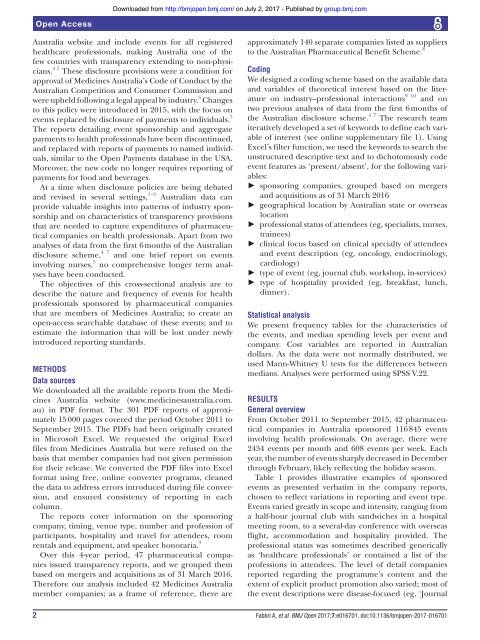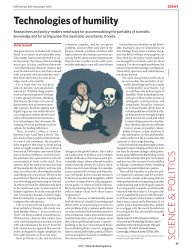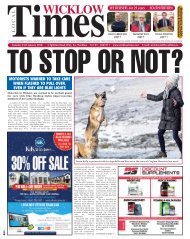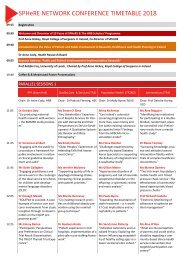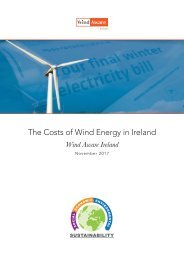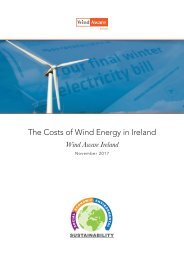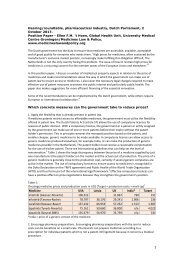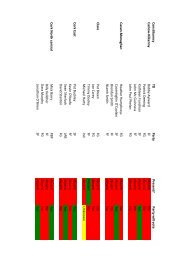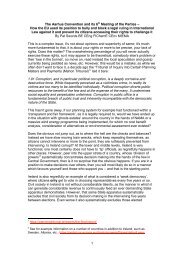A cross sectional analysis of pharmaceutical industry-funded events for HCPs in Australia_Fabbri_Mintzes
Create successful ePaper yourself
Turn your PDF publications into a flip-book with our unique Google optimized e-Paper software.
Downloaded from http://bmjopen.bmj.com/ on July 2, 2017 - Published by group.bmj.com<br />
Open Access<br />
<strong>Australia</strong> website and <strong>in</strong>clude <strong>events</strong> <strong>for</strong> all registered<br />
healthcare pr<strong>of</strong>essionals, mak<strong>in</strong>g <strong>Australia</strong> one <strong>of</strong> the<br />
few countries with transparency extend<strong>in</strong>g to non-physicians.<br />
4 5 These disclosure provisions were a condition <strong>for</strong><br />
approval <strong>of</strong> Medic<strong>in</strong>es <strong>Australia</strong>’s Code <strong>of</strong> Conduct by the<br />
<strong>Australia</strong>n Competition and Consumer Commission and<br />
were upheld follow<strong>in</strong>g a legal appeal by <strong><strong>in</strong>dustry</strong>. 6 Changes<br />
to this policy were <strong>in</strong>troduced <strong>in</strong> 2015, with the focus on<br />
<strong>events</strong> replaced by disclosure <strong>of</strong> payments to <strong>in</strong>dividuals. 3<br />
The reports detail<strong>in</strong>g event sponsorship and aggregate<br />
payments to health pr<strong>of</strong>essionals have been discont<strong>in</strong>ued,<br />
and replaced with reports <strong>of</strong> payments to named <strong>in</strong>dividuals,<br />
similar to the Open Payments database <strong>in</strong> the USA.<br />
Moreover, the new code no longer requires report<strong>in</strong>g <strong>of</strong><br />
payments <strong>for</strong> food and beverages.<br />
At a time when disclosure policies are be<strong>in</strong>g debated<br />
and revised <strong>in</strong> several sett<strong>in</strong>gs, 1–3 <strong>Australia</strong>n data can<br />
provide valuable <strong>in</strong>sights <strong>in</strong>to patterns <strong>of</strong> <strong><strong>in</strong>dustry</strong> sponsorship<br />
and on characteristics <strong>of</strong> transparency provisions<br />
that are needed to capture expenditures <strong>of</strong> <strong>pharmaceutical</strong><br />
companies on health pr<strong>of</strong>essionals. Apart from two<br />
analyses <strong>of</strong> data from the first 6 months <strong>of</strong> the <strong>Australia</strong>n<br />
disclosure scheme, 4 7 and one brief report on <strong>events</strong><br />
<strong>in</strong>volv<strong>in</strong>g nurses, 5 no comprehensive longer term analyses<br />
have been conducted.<br />
The objectives <strong>of</strong> this <strong>cross</strong>-<strong>sectional</strong> <strong>analysis</strong> are to<br />
describe the nature and frequency <strong>of</strong> <strong>events</strong> <strong>for</strong> health<br />
pr<strong>of</strong>essionals sponsored by <strong>pharmaceutical</strong> companies<br />
that are members <strong>of</strong> Medic<strong>in</strong>es <strong>Australia</strong>; to create an<br />
open-access searchable database <strong>of</strong> these <strong>events</strong>; and to<br />
estimate the <strong>in</strong><strong>for</strong>mation that will be lost under newly<br />
<strong>in</strong>troduced report<strong>in</strong>g standards.<br />
METHODS<br />
Data sources<br />
We downloaded all the available reports from the Medic<strong>in</strong>es<br />
<strong>Australia</strong> website (www. medic<strong>in</strong>esaustralia. com.<br />
au) <strong>in</strong> PDF <strong>for</strong>mat. The 301 PDF reports <strong>of</strong> approximately<br />
15 000 pages covered the period October 2011 to<br />
September 2015. The PDFs had been orig<strong>in</strong>ally created<br />
<strong>in</strong> Micros<strong>of</strong>t Excel. We requested the orig<strong>in</strong>al Excel<br />
files from Medic<strong>in</strong>es <strong>Australia</strong> but were refused on the<br />
basis that member companies had not given permission<br />
<strong>for</strong> their release. We converted the PDF files <strong>in</strong>to Excel<br />
<strong>for</strong>mat us<strong>in</strong>g free, onl<strong>in</strong>e converter programs, cleaned<br />
the data to address errors <strong>in</strong>troduced dur<strong>in</strong>g file conversion,<br />
and ensured consistency <strong>of</strong> report<strong>in</strong>g <strong>in</strong> each<br />
column.<br />
The reports cover <strong>in</strong><strong>for</strong>mation on the sponsor<strong>in</strong>g<br />
company, tim<strong>in</strong>g, venue type, number and pr<strong>of</strong>ession <strong>of</strong><br />
participants, hospitality and travel <strong>for</strong> attendees, room<br />
rentals and equipment, and speaker honoraria. 3<br />
Over this 4-year period, 47 <strong>pharmaceutical</strong> companies<br />
issued transparency reports, and we grouped them<br />
based on mergers and acquisitions as <strong>of</strong> 31 March 2016.<br />
There<strong>for</strong>e our <strong>analysis</strong> <strong>in</strong>cluded 42 Medic<strong>in</strong>es <strong>Australia</strong><br />
member companies; as a frame <strong>of</strong> reference, there are<br />
approximately 140 separate companies listed as suppliers<br />
to the <strong>Australia</strong>n Pharmaceutical Benefit Scheme. 8<br />
Cod<strong>in</strong>g<br />
We designed a cod<strong>in</strong>g scheme based on the available data<br />
and variables <strong>of</strong> theoretical <strong>in</strong>terest based on the literature<br />
on <strong><strong>in</strong>dustry</strong>–pr<strong>of</strong>essional <strong>in</strong>teractions 9 10 and on<br />
two previous analyses <strong>of</strong> data from the first 6 months <strong>of</strong><br />
the <strong>Australia</strong>n disclosure scheme. 4 7 The research team<br />
iteratively developed a set <strong>of</strong> keywords to def<strong>in</strong>e each variable<br />
<strong>of</strong> <strong>in</strong>terest (see onl<strong>in</strong>e supplementary file 1). Us<strong>in</strong>g<br />
Excel’s filter function, we used the keywords to search the<br />
unstructured descriptive text and to dichotomously code<br />
event features as ‘present/absent’, <strong>for</strong> the follow<strong>in</strong>g variables:<br />
► sponsor<strong>in</strong>g companies, grouped based on mergers<br />
and acquisitions as <strong>of</strong> 31 March 2016<br />
► geographical location by <strong>Australia</strong>n state or overseas<br />
location<br />
► pr<strong>of</strong>essional status <strong>of</strong> attendees (eg, specialists, nurses,<br />
tra<strong>in</strong>ees)<br />
► cl<strong>in</strong>ical focus based on cl<strong>in</strong>ical specialty <strong>of</strong> attendees<br />
and event description (eg, oncology, endocr<strong>in</strong>ology,<br />
cardiology)<br />
► type <strong>of</strong> event (eg, journal club, workshop, <strong>in</strong>-services)<br />
► type <strong>of</strong> hospitality provided (eg, breakfast, lunch,<br />
d<strong>in</strong>ner).<br />
Statistical <strong>analysis</strong><br />
We present frequency tables <strong>for</strong> the characteristics <strong>of</strong><br />
the <strong>events</strong>, and median spend<strong>in</strong>g levels per event and<br />
company. Cost variables are reported <strong>in</strong> <strong>Australia</strong>n<br />
dollars. As the data were not normally distributed, we<br />
used Mann-Whitney U tests <strong>for</strong> the differences between<br />
medians. Analyses were per<strong>for</strong>med us<strong>in</strong>g SPSS V.22.<br />
RESULTS<br />
General overview<br />
From October 2011 to September 2015, 42 <strong>pharmaceutical</strong><br />
companies <strong>in</strong> <strong>Australia</strong> sponsored 116 845 <strong>events</strong><br />
<strong>in</strong>volv<strong>in</strong>g health pr<strong>of</strong>essionals. On average, there were<br />
2434 <strong>events</strong> per month and 608 <strong>events</strong> per week. Each<br />
year, the number <strong>of</strong> <strong>events</strong> sharply decreased <strong>in</strong> December<br />
through February, likely reflect<strong>in</strong>g the holiday season.<br />
Table 1 provides illustrative examples <strong>of</strong> sponsored<br />
<strong>events</strong> as presented verbatim <strong>in</strong> the company reports,<br />
chosen to reflect variations <strong>in</strong> report<strong>in</strong>g and event type.<br />
Events varied greatly <strong>in</strong> scope and <strong>in</strong>tensity, rang<strong>in</strong>g from<br />
a half-hour journal club with sandwiches <strong>in</strong> a hospital<br />
meet<strong>in</strong>g room, to a several-day conference with overseas<br />
flight, accommodation and hospitality provided. The<br />
pr<strong>of</strong>essional status was sometimes described generically<br />
as ‘healthcare pr<strong>of</strong>essionals’ or conta<strong>in</strong>ed a list <strong>of</strong> the<br />
pr<strong>of</strong>essions <strong>in</strong> attendees. The level <strong>of</strong> detail companies<br />
reported regard<strong>in</strong>g the programme’s content and the<br />
extent <strong>of</strong> explicit product promotion also varied; most <strong>of</strong><br />
the event descriptions were disease-focused (eg, ‘Journal<br />
2 <strong>Fabbri</strong> A, et al. BMJ Open 2017;7:e016701. doi:10.1136/bmjopen-2017-016701


